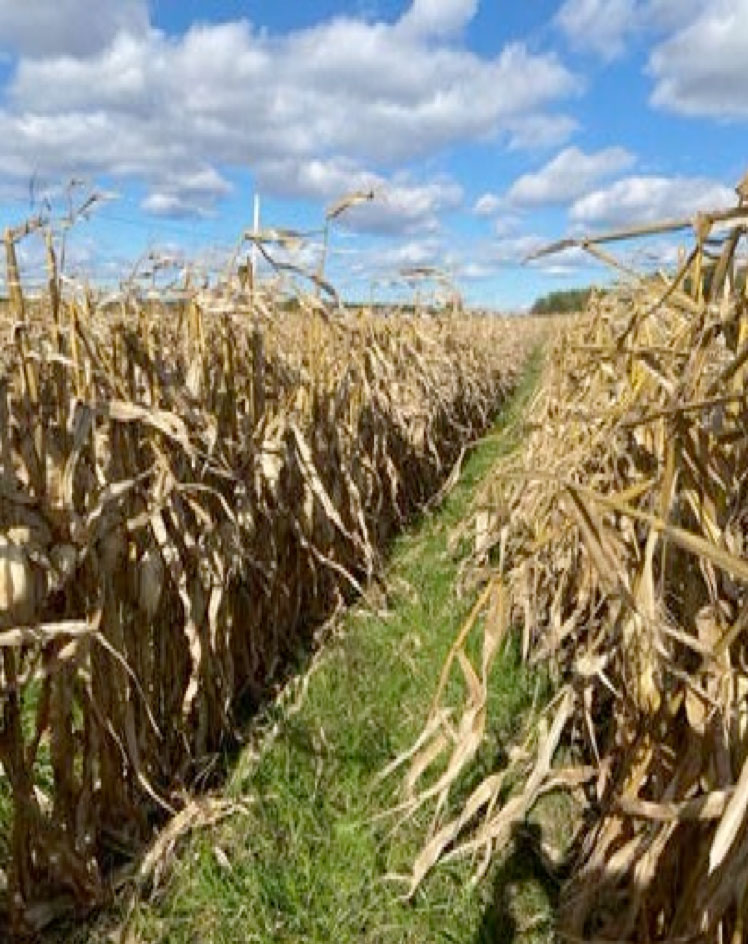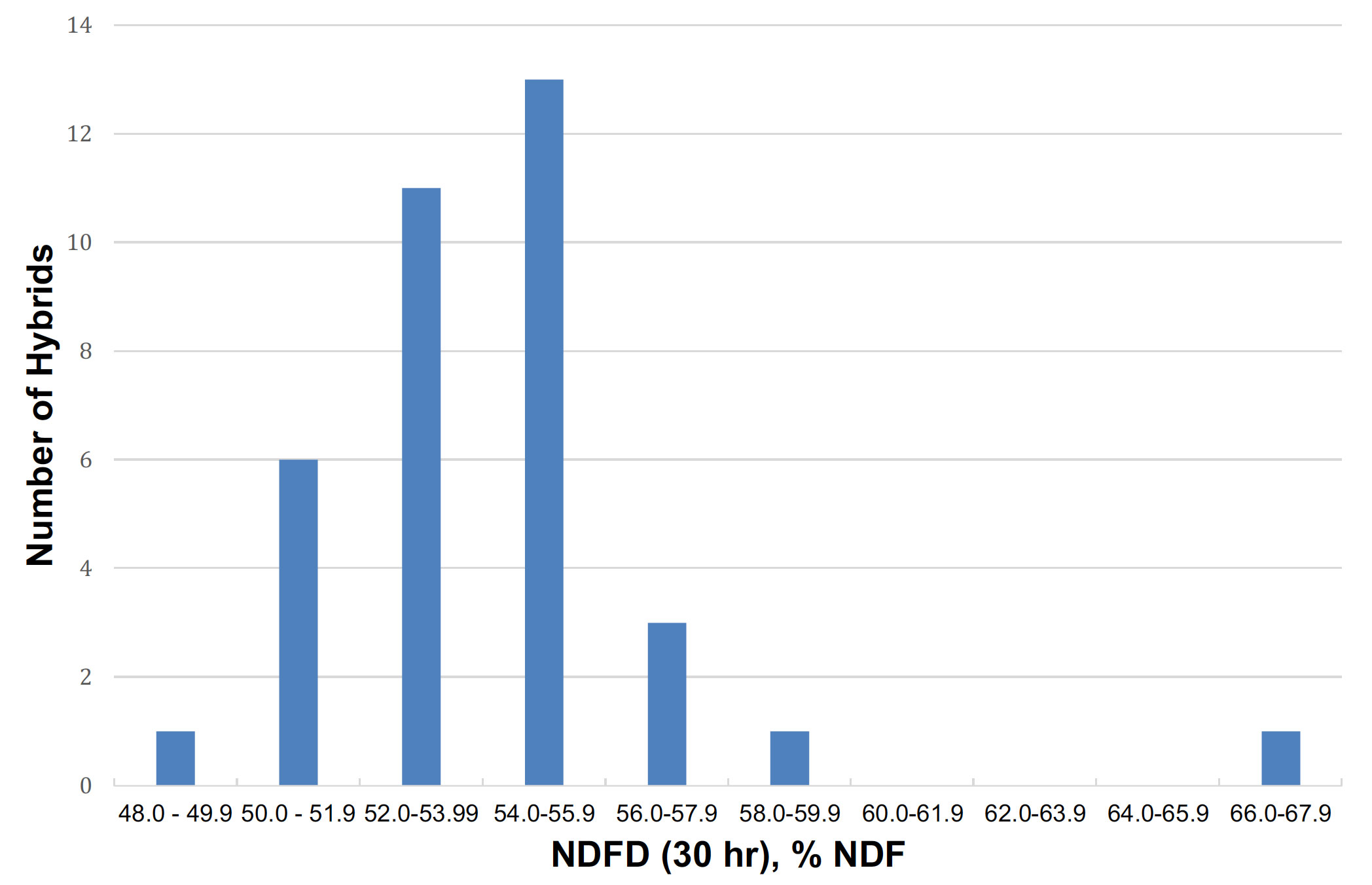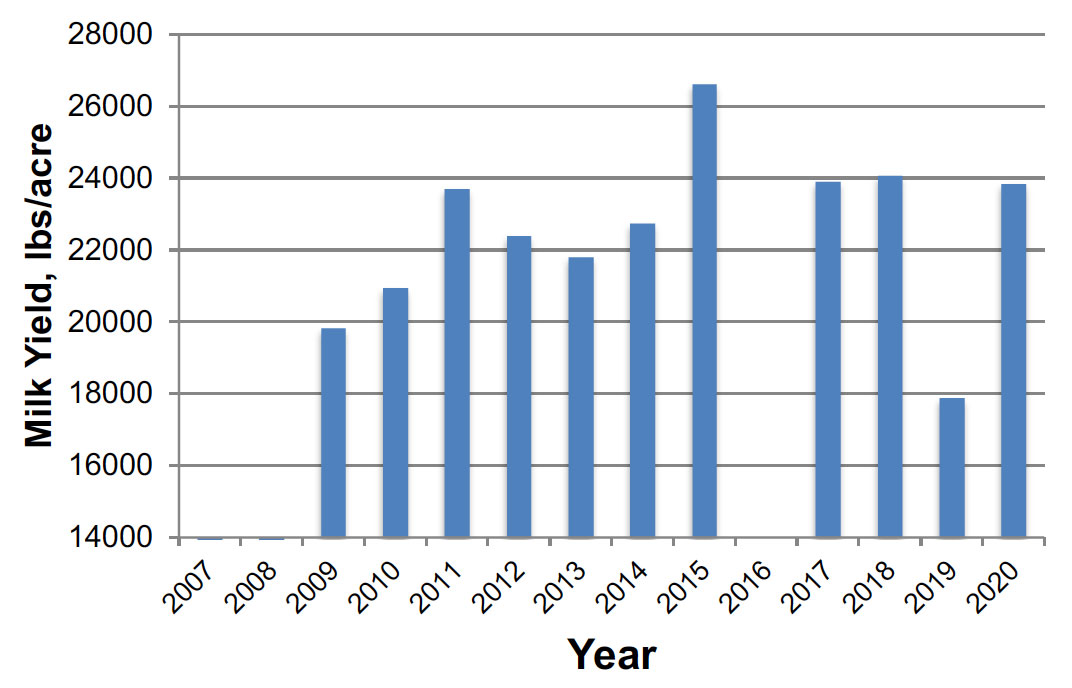Maine Corn Silage Hybrid Trial 2020 Results
Maine Corn Silage Hybrid Trial 2020 Results (PDF)
Rick Kersbergen
207.342.5971
richard.kersbergen@maine.edu
Caragh Fitzgerald
207.622.7546
cfitzgerald@maine.edu
Location: Misty Meadows Farm, Clinton, Maine Soil type: Woodbridge fine sandy loam Planting date: May 22, 2020
Fertility: 10,000 gallons/acre liquid manure + 75 lbs/A N (sidedress)
Herbicide: pre emergence 2 ½ qt. Acuron + 1 Qt. Atrazine + 1Qt. MaKaze post emergence: 3 qt Yukon + 1 Qt Makaze
Plot size: 15’ x 75’
Treatment arrangement: Randomized complete block design with 3 replications Target planting density: 32,000 plants/acre
Harvest date: September 11, 2020. No frost had yet occurred. Silage harvest was underway in the region.
Growing degree days: 2345 (86/50) (Climate Smart Farming) This was a historical record for the time period between planting and harvest.
Rainfall: 7.94 inches (NWS, Waterville, ME)
Harvest weights: Corn from each plot was chopped into a mixer wagon with scales.
Quality samples: Collected September 10, 2020. Three stalks per plot were randomly selected and chopped with a portable chipper. The chopped material was mixed, and a subsample was collected, frozen, and shipped for analysis (Cumberland Valley Analytical Services).
Data analysis: Analysis of variance was conducted using JMP. When a significant effect was found, linear regression analysis was conducted to see the effect of relative maturity on these parameters.
Results
Yield and Expected Milk Yield
Yields were corrected to a standard 30% dry matter. Forage digestibility and energy content were used to project potential milk yield (pounds of milk/ton of dry matter). Expected milk yield per acre was calculated by multiplying the potential milk per ton of dry matter by the tons of dry matter per acre. This serves as another measure of productivity of each hybrid. Both yield (30% DM) and expected milk yield results are shown in Table 1.
Average plot yield and milk yield were impacted in 2020 by low rainfall and record level growing degree days. Average yield over all plots was over 25 tons per acre corrected to 30% dry matter with an estimated milk yield of 23,875 lbs. of milk per acre.
Analysis of variance showed that there were significant differences among the hybrids tested for both yield (p=0.0023) and estimated milk yield (p=0.0055). In Table 1, hybrids followed by the same letter are statistically similar (Tukey’s HSD). When comparing most pairs of hybrids, the means were statistically equal.
There was a statistically significant linear correlation between relative maturity and yield (30% dry matter) (p=0.0084). This relationship was weak, with an r2 of 0.064291. There was no statistically significant linear correlation between relative maturity and estimated milk yield (p=0.2523).
Quality
Tables 1 and 2 lists select quality results for the 2020 trial.
In 2020, we encountered the most intense GDD (Growing Degree Days) season on record with an accumulation of 2345 GDD. Unfortunately, we also encountered several periods of moisture deficit with predictions of severe water deficit from 6/15-6/29, 7/31-8/5 and 8/10-8/25. (Climate Smart Farming)
Harvest moisture average was 32% dry matter with a range of about 28% DM to 39.5% DM. The variety with the highest dry matter at harvest was also the variety with the shortest predicted relative maturity (75 RM DynaGro D15VC77).
One way to select high-performing hybrids is to identify those that have both high crop yield and high milk yield (estimated pounds of milk per ton of dry matter). Within an experiment, we can compare hybrids by looking at their relative yields. Relative yields can be calculated by dividing a hybrid’s yield by the average yield of the whole experiment. Those hybrids with relative yields greater than 100% performed better than average, while those with relative yields less than 100% performed worse than average for the experiment. Figure 3 shows the relative crop yield and relative milk yield. Hybrids that yield better than average for both parameters are in the upper right quadrant of the graph.
Another measurement of interest that many nutritionists use in developing rations is uNDF Dig (240 hr.). A good example of how this impacts rations is seen in hybrid 28, the only entry in the 2020 that was a BMR variety and had the lowest uNDF percentage. While the BMR variety did not have the lowest ADF or NDF values, it did have the highest NDF digestibility and one of the lowest starch values. This is important when feeding rations that include corn silage as the major portion of the forage component of the diet.
Discussion
2020 provided Maine corn silage growers with one of the warmest on record. Good soil conditions also offered growers the ability to plant earlier and harvest the crop at the correct moisture content for most varieties before a killing frost.
Drought conditions throughout the state probably limited yield and quality parameters.

Researchers also used this opportunity to compare growing the same variety in 30-inch rows versus 60-inch rows with double the planting population in the row (estimated 32,000 seeds per acre for both plots). Variety 36 was the same as variety 27, but planted at 60-inch rows. Looking at variety 27 compared to variety 36, you can see that the yield in tons/acre and milk yield (lbs/ton of DM and lbs/acre) are not statistically different. Researchers were interested in the potential for 60-inch rows to facilitate interseeding cover crops during the growing season. Data from another site indicates significant cover crop growth with interseeding corn at 60-inch rows versus 30-inch rows
Shorter season hybrids offer options for improved cover crop establishment and the potential for double cropping. Although they may be slightly less productive in some growing seasons, this additional crop flexibility can significantly improve the total yield of digestible nutrients per acre. There is risk associated with growers choosing longer season hybrids for higher yield, especially given changing climate conditions with large swings in growing conditions from year to year. By choosing short-season or mid-season varieties, producers help to guarantee a level of maturity and dry matter that produces quality corn silage that ferments well in the silo. They become less vulnerable to late wet harvest years. This also opens the door for improved nutrient and soil management options such as cover cropping.
Acknowledgements
We would like to thank John Stoughton and the farm crew at Misty Meadows Farm for their help with planting, crop management, and harvest. We also thank Barney Wright and the Wright Place farm crew for lending a planter in the spring and a weigh wagon and driver for harvest time. Thanks are also extended to the seed dealers who helped with seed donation, planting, and harvesting and to staff and students who helped in the field and in the office.
| Month | Rain (inches) |
|---|---|
| May (after planting) | 0.08 |
| June | 1.83 |
| July | 4.68 |
| August | 1.28 |
| September (before harvest) | 0.07 |
| Total | 7.94 |
——





| Company | Contact | Phone |
Channel |
DeKalb |
Dynagro |
Master’s Choice |
Brevant |
NK |
Red Tail |
Schlessman |
Seedway |
|
|---|---|---|---|---|---|---|---|---|---|---|---|---|
| Seed Solutions Inc. | Matt Blodget | 207.768.1711 | matthewblodget @gmail.com |
x | ||||||||
| Nutrien Ag Solutions (Office: 207.764.1860) |
Brian McCleary | 207.740.1911 (M) | brian.mccleary @nutrien.com |
x | x | x | x | |||||
| Franklin Leavitt | 207.944.1922 (M) | frank.leavitt @nutrien.com |
x | x | x | x | ||||||
| Randy Drown | 207.650.0310 (M) | randy.drown @nutrien.com |
x | x | x | x | ||||||
| Todd Winslow | 207.551.6806 (M) | todd.winslow @nutrien.com |
x | x | x | x | ||||||
| Fedco Seeds | Alice Percy | 207.426.8247 | alice @fedcoseeds.com |
x | x | |||||||
| Gold Star Feed and Grain, LLC | Michele Bennett | 207.754.0764 | mbennett @goldstarfeed.com |
x | x | x | ||||||
| Emilee Robertson | 207.399.6755 | erobertson @goldstarfeed.com |
x | x | x | |||||||
| Andy Dugan | 315.841.4167 | adugan @goldstarfeed.com |
x | |||||||||
| R. Keith Hines | 207.717.9558 (M) | hinesclan @reagan.com |
x | |||||||||
| Warren Hood | 207.754.1853 (M) | hoodlah @aol.com |
x | |||||||||
| Kent Nutrition Group | Nick Richardson | 207.317.0469 | nicholas.richardson @kentww.com |
x | ||||||||
| King’s Agriseeds, Inc. | Rod Porter | 607.227.0836 | rodporter @kingsagriseeds.com |
x | x | |||||||
| Master’s Choice | Kyle Vosburgh | 618.697.7031 | kyle @seedcorn.com |
x | ||||||||
| Nick Michaud | 207.649.9786 | michaudfarm @gmail.com |
x | |||||||||
| Brevant | Claude Fortin, area mgr | 802.363.2803 | claudefortin @comcast.net |
x | ||||||||
| Northeast Agricultural Sales (Office: 800.462.7672) |
Justin Choiniere | 802.535.9938 (M) | justin @neag.net |
x | x | x | ||||||
| Paul Peters | 207.441.6250 (M) | pumpkinpaul1 @aol.com |
x | x | x | |||||||
| Paris Farmers Union | Jennifer Bailey | 207.744.5598 | jenb @parisfarmersunion.net |
x | ||||||||
| Tim Donovan | 207.744.5602 | timdonovan.pfu @gmail.com |
x | |||||||||
| R.E. Belanger & Son | Rick Belanger | 207.576.5845 | veggiefarmerinme @roadrunner.com |
x | ||||||||
| Seedway | Taylor Putnam, area mgr | 207.703.3046 | putnam.taylor @gmail.com |
x | x | |||||||
| Syngenta/NK | Brendan Evans | 607.302.0646 | Brendan.evans @syngenta.com |
x |
